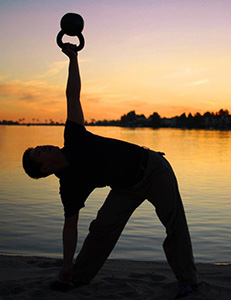Nearly a year ago, I wrote an article that discussed rehabbing injuries with kettlebell exercises. It was a topic that fascinated me at the time and one that I still find very intriguing. Apparently, I’m not the only person as it’s one of the more popular posts on this site. The research I did for the article concluded that not only can kettlebells help with injuries but pain management as well. This information wasn’t opinion-based or speculative but actually came from studies by doctors and physical therapists.
One of those Doctors, Dr. Ben Fung, has devoted much of his time helping others recover from injuries by using kettlebells. He’s written a thesis on the subject (published by the American College of Sports Medicine) and even developed his own protocol. I’ve scoured the internet looking for input from other Doctor’s but no one has gone into such detail as he. It’s been a long time coming, however, I finally worked up the nerve to contact him directly to learn more about his research.
Dr. Fung is a pretty busy guy these days but he still found time to answer my questions. It’s clear from his answers that he’s still as passionate about kettlebells as he was 10 years ago. It used to be thought that kettlebells were just a fad for the latest fitness trend. Now we’re learning that they offer many more benefits by improving mobility, alleviating pain, and helping people of all ages with injury recovery. Check out my interview with Dr. Fung and his thoughts about kettlebell rehab below!
Dr. Ben Fung Interview
Let’s talk about your career change from a physical therapist to a keynote speaker & presenter. What’s been the motivation behind this change and can you briefly the explain goals you hope to achieve?
This was a natural progression being a physical therapist in a trauma 1 hospital doing all sorts of work while also teaching a community wellness class based on kettlebells; leading me into corporate management; ultimately starting my own companies — UpDoc Inc, which houses three divisions in media, marketing, and business development — and, Recharge LLC, a modern health and fitness practice based out in Maryland aiming to create healthier communities.
It’s been 10 years since your thesis on kettlebell exercise has been published. Has anything changed since then on the subject? Do you still use kettlebells for your own personal health?
There’s been a lot more acceptance from the clinical world with the use of kettlebells. Big research names such as Dr. Stuart McGill are now unashamed fans of kettlebell exercise. Overall, I think kettlebells have been demystified in a positive way; however, it still comes with the challenge of being a novelty item that less than scrupulous individuals may take advantage of for the general consumer — to their own detriment or the detriment of clients/patients. I very much still use kettlebells for my own personal health; they are embedded in my weekly regimen.
Back in 2010 you developed the Fung Protocol which includes 30 seconds of exercising followed by 30 seconds of rest for 6 kettlebell exercises repeated for 3 rounds. This appears similar to Tabata which has only recently gained popularity. How did you decide on those specific exercises and time duration?
As my research was technically a pilot, and, if memory serves was cited by an NSCA article as the first contemporary scientific exploration of the benefits of kettlebells — my research advisor and I had to come to a reasonable protocol that was similar enough to cardiopulmonary methodologies such as the progressive Bruce, and, the Tabata which was certainly gaining early traction during the time of my research. Our conclusion was to blend the two. Tabata was going after a different effect and the aim of our study was to investigate the claims of cardiopulmonary benefits; therefore our emphasis was making exercise more sustainable for VO2 measures.
Browsing through some of your older blog posts, I see you’ve come up with some creative kettlebell exercise activities. For example, the Partner Swing Relay and the Hot Potatoes. Are there any other unique kettlebell activities you’d like to share?
Some of my favorite kettlebell exercises and activities are partner-based or circuit driven — whereby a singular station may be responsible for an entire group moving to the next station in the circuit. Kettlebell tosses in the sand, such as at the beach, for a total rep and distance is always fun. A three-way or four-way pull-over or skull crusher done supine is always an entertaining affair. But, to be honest, over the years — I’ve found the fundamentals to be of most value in the world of kettlebells.

Dr. Fung performing a kettlebell windmill.
In regards to rehabbing an injury with kettlebells, I watched a testimonial of a former patient of yours who recovered quickly from a back injury. What’s been the biggest recovery you’ve witnessed thanks to kettlebell exercises and workouts?
I’ve seen recovery from back injury, relief from generalized chronic pain, and shoulder recovery to be the areas of highest benefit. Knee/hip pain has been of success as well in terms of regions of the body. As memory serves, the two biggest cases were the one you’ve mentioned from a back injury and a mid-aged woman who had suffered from fibromyalgia all her life. The remark struck me was when after 8 weeks of kettlebells she commented that she, for the first time in ages, had no pain in her knees… something that had been ailing her for as long as she could remember.
Going back to the Fung Protocol, I’m curious how you came to the conclusion of limiting kettlebell weight to 13% or less of body weight to keep it a strictly aerobic workout. Does this account for obesity?
We weren’t able to take into account of obesity due to sample size. The calculation came from measuring VO2 and VCO2, coming to a Respiratory Quotient (RQ) = 1.0. Conventionally, this is considered perfectly aerobic. We also noticed that if the kettlebell weight was greater than 13% of body weight, the participants went into exercise states that were slightly more anaerobic than aerobic — not that there was a decreased amount of cardio-per-se. From a metabolic point of view, one would be “burning” more efficiently at 13% of body weight. However, one very likely would be burning more with increased strength benefits working at greater than 13% body weight.
Many of your articles highlight the negative effects that gym machines have on the joints. Kettlebell exercises, on the other hand, hardly put any stress on the joints. Why is that?
This was an operational assumption we had due to the theory at the time of the early 2010s of joint mechanics; and, wear and tear over time and use. Certainly, this perspective has evolved over the last decade with many articles demonstrating that the body is rather resilient with some machines not offering that terrifying shear forces we once were so afraid of. However, there is still conventional wisdom in avoiding high amounts of forces in tissue areas that have not been properly loaded or conditioned to accept large stresses and strains under load/weight.
All that said, the bioengineering colleague from undergraduate days that I consulted agreed that the angular momentum of most kettlebell activities move congruently with most of our joint mechanics as most of our joints are round and move in swinging fashions vs. the linear mechanics of gym machines. If memory serves, I believe there was a physical therapy based study on the shear forces at the lumbar spine with kettlebell swings which showed a restorative reverse shearing — something that is considered rehabilitative in nature to the low back.
I was fascinated to learn that due to physics, the average kettlebell swing exerts forces on the body 4 to 6 times that of the weight of the kettlebell. This was the conclusion you and another engineering colleague came to and I am wondering if you can provide some more insight on that study?
Yes, these were numerically calculated using engineering principles. We weren’t able to verify these numbers in our study as my pilot was focused on cardiopulmonary effects. I believe I’ve seen studies try to replicate this; some have confirmed such numbers while others have noted variance due to a participant’s differences in anatomy and technique.
Aside from the swing or snatch, what’s your favorite kettlebell exercise and why?
The Turkish Get Up (TGU). To be specific, just even the 1st half of the TGU progression up until the oblique bridge. While there are perhaps 20 different variants or so — most TGUs are done in a way where one must have both the core strength and vertical stability to engage the shoulder girdle overhead as well as the hip mobility to move into a kneeling position. This is probably my favorite exercise for overall body mobility as well as shoulder rehab. I’ve also seen this do wonders for generalized back pain.
Thanks for your time today Dr. Fung. I always like to reserve this last question for guests to discuss whatever they’d like. Whether that’s something you’d like to promote, an inspirational note, or even anything completely unrelated.
If anyone has any questions, or is interested in joining me for a course early June-2020, please contact me at ben@updocmedia.com.



